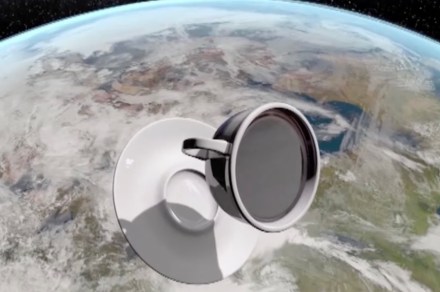Watch how astronauts drink coffee in space

Like many folks, astronauts enjoy a cup of joe from time to time, but the lack of gravity means that preparing and drinking it is a little different from how you do it back on terra firma.
With that in mind, NASA has just released a short video (above) revealing how astronauts aboard the International Space Station (ISS) get their daily coffee fix.
To get the water for their brew, the astronauts use a specially designed water dispensing unit that takes recycled liquids and moisture drawn from the air. Once the water has been heated, the astronaut grabs a plastic pouch filled with freeze-dried coffee grounds, connects it to the unit, and fills it with the hot water. After that, they can go off to enjoy their coffee, sipping it through a straw. Or from a cup … let us explain.
Zero Gravity coffee cup
Back in 2008, one astronaut, Don Pettit (who happens to be aboard the station right now, too), decided that he wanted to enjoy his coffee in the more traditional way, by drinking it from a mug. So he invented what eventually became known as the Zero Gravity coffee cup, and you can see it in the video. To make a prototype, Pettit tore a piece of plastic from his Flight Data File mission book to create a teardrop-shaped drinking vessel. The design relies on surface tension and the laws of physics to keep the liquid from floating away in the microgravity conditions.
Further development and refinement of the design led to the Zero Gravity coffee cup becoming the first patented product invented in space.
Now that you know how astronauts drink coffee in space, you may be wondering how they go to the bathroom — apparently this is the question that astronauts get asked most. Well, this video explains all about astronauts’ bathroom routine.
For more insight into how astronauts live and work aboard the space station, take a look at this collection of videos made over the years by visitors to the orbital outpost.
![]()
Not so many moons ago, Trevor moved from one tea-loving island nation that drives on the left (Britain) to another (Japan)…
Crew Dragon is about to fly with empty seats for the first time. Here’s why

NASA and SpaceX are making final preparations for the Crew-9 astronaut flight to the International Space Station (ISS), which is set to launch from the Kennedy Space Center in Florida on Thursday, September 26.
But this will be the first of SpaceX’s 13 crewed flights to the ISS since the first one in 2020 where there will be two empty seats on the Crew Dragon spacecraft. And there’s a very good reason for that. Let us explain.
Polaris Dawn’s high-speed journey home captured in photo from ISS

A remarkable photo taken by an astronaut aboard the International Space Station (ISS) shows SpaceX’s Polaris Dawn Crew Dragon capsule entering Earth’s atmosphere at high speed as it returned home with four crew members on board early on Sunday morning.
Close examination of the image (top), which was captured by recent ISS arrival Don Pettit, shows a streak of light and the Crew Dragon, with some city lights visible in the background. The five-day Polaris Dawn mission carried four non-professional astronauts and performed the first-ever privately funded spacewalk while also taking humans to the furthest point from Earth since the Apollo missions five decades ago.
Starliner astronauts speak of ‘tough times’ watching their spacecraft depart without them

NASA astronauts Butch Wilmore and Suni Williams have spoken publicly for the first time since the Boeing Starliner departed from the International Space Station (ISS) without them. In a news conference from the ISS held Friday, the pair spoke about dealing with the uncertainty around whether they could fly home on the Starliner and the adjustment from what they expected to be an eight-day mission to staying on the space station for eight months.
“It was trying at times. There were some tough times, all the way through,” Wilmore said. “As the commander and [pilot] of your spacecraft, you don’t want to see it go off without you. But that’s where we wound up.”


